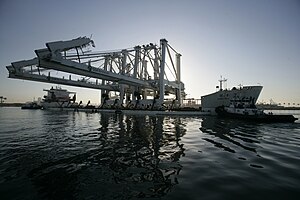Port of Long Beach
| Port of Long Beach | |
|---|---|

Part of the Port of Long Beach
|
|
| Location | |
| Country | United States |
| Location | Long Beach, California |
| Coordinates | 33°45′15″N 118°12′59″W / 33.754185°N 118.216458°W |
| Details | |
| Opened | June 24, 1911 |
| Land area | 3,200 acres (13 km2) |
| Available berths | 80 |
| Piers | 10 |
| Statistics | |
| Annual cargo tonnage | 78.2 million metric revenue tons (CY 2010) |
| Annual container volume | 6.73 million twenty-foot equivalent units (TEU) (CY 2013) |
| Value of cargo | $56.7 billion USD (CY 2010) |
| Draft depth | >50 feet |
| Air draft | unrestricted |
|
Website http://www.polb.com/ |
|
The Port of Long Beach, also known as the Harbor Department of the City of Long Beach, is the second-busiest container port in the United States, after the Port of Los Angeles, which it adjoins. Acting as a major gateway for US–Asian trade, the port occupies 3,200 acres (13 km2) of land with 25 miles (40 km) of waterfront in the city of Long Beach, California. The Port of Long Beach is located less than two miles (3 km) southwest of downtown Long Beach and approximately 25 miles (40 km) south of downtown Los Angeles. The seaport generates approximately US$100 billion in trade and employs more than 316,000 people in Southern California.
San Pedro Breakwater was started in 1899 and over time was expanded to protect Port of Long Beach. The Port of Long Beach was founded on 800 acres (3.2 km2) of mudflats on June 24, 1911, at the mouth of the Los Angeles River. In 1917, the first Board of Harbor Commissioners was formed to supervise harbor operations. Due to the booming economy, Long Beach voters approved a $5 million bond to improve the inner and outer harbor in 1924. By 1926 more than one million tons of cargo were handled, and additional piers were constructed to accommodate the growing business.
The old Municipal Pier was rebuilt into the Municipal Wharf in 1925. In 1925 construction started on Pier A and Pier B, with opening of Pier A in 1930.
In 1921, oil was discovered at the Long Beach Oil Field on and around Signal Hill. In 1932, the fourth-largest oil field in the United States, Wilmington Oil Field, was discovered; much of this field was underneath Long Beach and the harbor area itself. The hundreds of oil wells from Wilmington Oil Field provided oil revenues to the City and Port of Long Beach. The first offshore oil well in the harbor was brought online in 1937, shortly after the discovery that the oil field far extended into the harbor. In the mid-1930s, the port was expanded, largely due to the need to transport oil to foreign markets, as the immense output of oil from the Los Angeles Basin caused a glut in US markets.
...
Wikipedia
